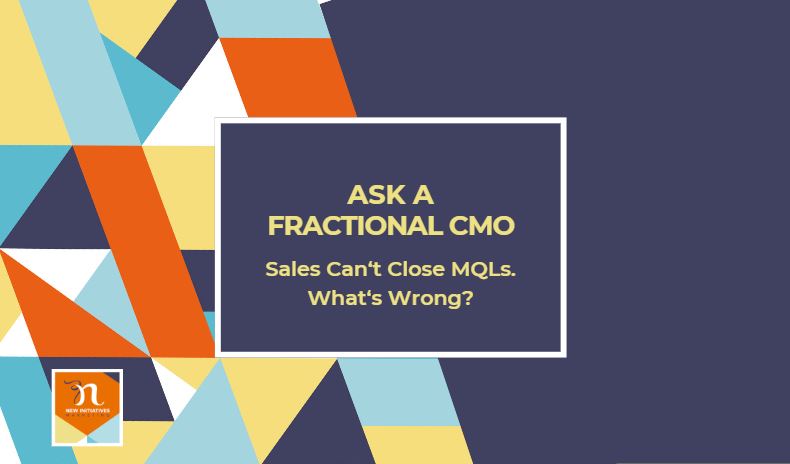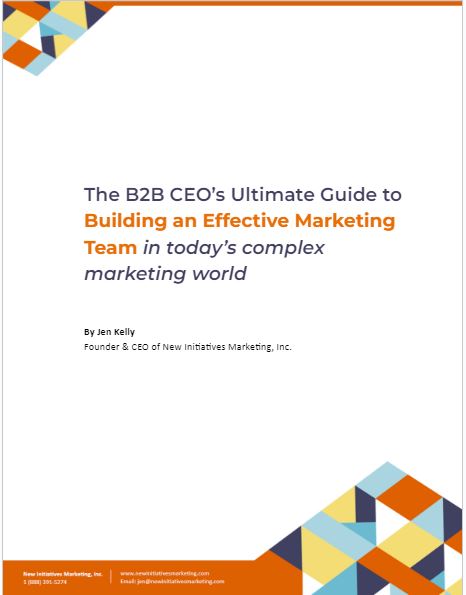“Our sales reps can’t close MQLs. How do we bring in more qualified leads?”
Welcome to another edition of Ask a Fractional CMO, the monthly newsletter where we tackle pressing questions in the B2B marketing landscape. Today, we’re diving into a common question we encounter in our Ask a Fractional CMO newsletter: “Our sales reps can’t close MQLs. How do we bring in more qualified leads?
We love this question because it really speaks to a very common problem in the B2B world right now: Not properly defining MQLs (Marketing Qualified Leads) vs. SQLs (Sales Qualified Leads), and having your sales reps follow up on leads too soon, and disrupting the buyer’s journey for your ideal clients.
Many B2B firms tag a lead as an MQL when they’ve taken one initial action that expresses some interest, such as downloading an eBook. This should indicate an initial expression of interest, and the goal with marketing should be to include additional steps, materials or ways of moving that lead with initial interest to become an SQL. This process can take a longer or shorter time depending on the lead.
A common signal that many B2B firms use to signal that a lead has become an SQL is when they fill out a form to request a demonstration or something similar. And this is when the lead has indicated a strong interest, a signal that they are close to being ready to make a decision, and a desire to engage with a sales rep. This is the time when sales reps SHOULD be following up with leads.
But that’s not what’s happening with many B2B firms. Instead, sales reps are being directed to follow up with leads IMMEDIATELY after a lead takes a single action, like downloading an eBook – but they’re not able to convert these leads.
B2B CEOs often jump to the conclusion that there’s a problem on the marketing side – they’re not bringing in leads that are well qualified. But the reality is that sales reps are following up way too early in the buying journey. Not only that, they are likely annoying these leads and turning them off the company.
This is an important topic in the B2B world, and we dive more deeply into this question in our video answer below:
Here is a high level summary of the video transcript – for all the details, be sure to watch the video above.
Jen: This is an interesting question and it raises the issue of differentiating between marketing qualified leads and sales qualified leads. Often, B2B companies set up processes where a lead magnet, like an ebook download, captures email addresses, and then the leads go into the CRM system. Unfortunately, some companies immediately follow up with a sales call at this stage, which, in our opinion, is not ideal.
Nicole: Yes, we do see that happening. Sales reps might follow up by phone, email, or chat immediately. However, this is usually not the right time to push for a sale. The initial contact point should be seen as the start of the customer’s journey, not the moment to close a deal.
Jen: Precisely. When companies interpret this initial action as a signal to make a sale, it often leads to frustration because potential buyers are still in the early stages of researching and educating themselves. They are not ready to make a purchase.
Nicole: That’s right. Many B2B companies misinterpret these early signals as unqualified leads. Instead, it’s important to respect the buyer’s pace and provide them with the information they need as they progress through the sales journey.
Jen: To determine when to follow up, organizations should define what a sales qualified lead means for them. It’s different for each company. Some buyers prefer to self-educate and progress through most of the sales process independently. They want information readily available on the website and might only engage when they’re ready for a sales demo.
Nicole: Exactly. Offering resources like short videos, trial versions, or informative content can help potential buyers move along the journey. Then, when they’re ready for questions or assistance, they can reach out to the sales team.
Jen: In summary, the key is to understand your buyer’s journey and not disrupt it too early by pushing for a sale after an initial interaction. Let buyers take themselves through the process, and be ready to engage when they signal their readiness, often by requesting a sales demo.
Nicole: Absolutely. Avoid interrupting the buyer’s journey, and you’ll have a better chance of converting those leads into sales.
Jen: So, for the question of how to bring in more qualified leads, focus on understanding and respecting your buyer’s journey, and provide the right resources at the right time.
Nicole: And remember, not all initial interactions should lead to immediate sales calls. Let the buyers guide themselves through their journey.
Next Steps: The CEO’s Ultimate Guide to Building an Effective B2B Marketing Team in Today’s Complex Marketing World
To help you make important decisions around your marketing investment, we’ve created a comprehensive eBook: The B2B CEO’s Ultimate Guide to Building an Expert Marketing Team in Today’s Complex Marketing World
In this eBook, we walk you through the six most important questions B2B CEOs need to answer in order to build their first marketing team and choose the right marketing model for their stage of business:
- How Do You Know It’s Time to Invest in Marketing?
- What are B2B Marketing Best Practices?
- How Has B2B Marketing Become More Complex?
- What Are the Top Challenges in Getting Started in Marketing?
- What Does a B2B Marketing Team Look Like?
- Should You Hire In-House or Outsource?
You can download the eBook RIGHT HERE
Book a Marketing Strategy Consultation:
If you have any questions about this blog post or the eBook or would like to schedule a consultation with Jen Kelly, NIM’s Founder and one of the Fractional CMOs to get more guidance around your next steps in marketing, you can send her an email or book a consultation time.


